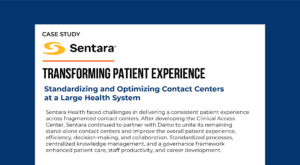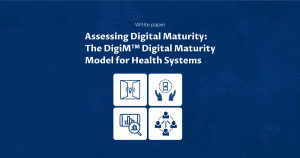The future of patient data: 3 pillars of successful analytics implementation
In the COVID-19 era, health systems recognize that existing data infrastructure is inadequate. Here are the three things large datasets need to be useful.

Originally published on Healthcare IT News
Wearables and smartphone apps have grown in popularity in recent years. More patients are self-monitoring their health parameters and bringing that data to appointments. According to Gartner, in 2021, worldwide end-user spending on wearable devices will total $81.5 billion, an 18.1% increase from $69 billion in 2020.
Today, healthcare consumers are more empowered with the health data readily available through healthcare information tools and devices. Informed patients track every aspect of their care from many sources, including personal gadgets, health apps, consults from multiple specialties, and diagnostic centers.
The influx of healthcare data from many sources, and open API technologies, are changing how patients are coming prepared for outpatient consultations. They expect healthcare at home health settings, armed with data and analytics from their devices and google research.
On the other hand, data is abundant for health systems and physicians, coming in from multiple sources – patient-care applications, personal and medical equipment, hospital administration, operations, supply chain, logistics, referrals and human resource management.
This healthcare data can solve real-life problems in everyday workflows, like getting appointments for available slots, getting the dietary patterns for patients with chronic diseases, supply chain logistics for PPE kits, medication inventories, lists of patients that require routine laboratory testing, and identifying gaps in regulatory compliances.
The list is long. Developers on EHR marketplaces like Epic Orchard, Allscripts Applications Store, and Athenahealth marketplace testify to the increasing number of apps being released regularly for different workflows across administrative, clinician, patient, and backend infrastructure users.
Health systems have obtained data from various sources thanks to technological disruptions and open FHIR APIs in the last decade. Orchestrating all the data continues to remain a challenge. From a technical standpoint, the key components include data integration from multiple sources, hosting it in data marts aligned with specific business processes, and the flexibility to scale as needed.
This is analogous to stacking identical items on separate shelves of a grocery shop for convenient consumption. After assembling data, it can provide actionable insights to business partners. What are the technical criteria that will allow healthcare data analytics to benefit both consumers and health systems? How has healthcare technology changed in the previous ten years? Here’s my prediction for what will happen to patient data and access in 2022.
Enterprise digital transformation: 3 pillars for success
During the pandemic, large health systems were quick to adapt and manage various care and operational workflows. Data was saved, normalized, and analyzed from multiple sources. They brought together healthcare data from disparate sources and created supply chain workflows for delivering PPE kits, maintaining medical inventories, tracking patients in need of COVID-19 testing, improving virtual and telehealth platforms to care for routine visits, and installing remote devices to coordinate eldercare and vulnerable patient care.
Data became the source to which huge organizations turned to put all the jigsaw pieces together in a cloud infrastructure.
In the COVID-19 era, health systems recognize that existing data infrastructure is inadequate in meeting the different needs of several stakeholders. Large data volumes require three things to be useful: a place to live – hosting in a cloud, the ability to exchange it – interoperability, and a comprehension of the semantics or language – terminology standards.
Health cloud. Enterprise digital transformation has been using the power of the cloud for quite some time now, making partial migrations of their technology infrastructures to the cloud. Today, most health systems are in a hybrid model, with some applications on the cloud and some on-premises.
The big tech firms like Google, Microsoft, Amazon, and Salesforce provide the infrastructure that includes data ingestion in multiple formats, data transformation to healthcare standard formats, storage, and finally sharing them across users in FHIR format.
A health cloud is a unified repository of data across systems and care settings. It empowers healthcare organizations to rapidly develop scalable applications that unlock the power of data to improve clinical, operational, and financial outcomes.
Interoperability. Healthcare data formats include text, graphics, numeric, paper, digital, photos, videos, multimedia, radiological images, ECG waveforms, and others complicate it further. Raw data in healthcare can be in various formats, including flat files, XML, JSON, database extracts, and standard-based documents like HL7, CDA, or X12.
A cloud platform needs to parse, codify and store the data within a unified data model with standard ontologies. Only then can it be leveraged by downstream applications to support the patients and their providers in each step of the journey. Normalizing this data and running intelligent algorithms on top of it can provide valuable insights across all functions.
Standard Terminologies. Having different systems speak the same language as part of the standardized ontology exercise. The recommended USCDI data classes for clinical and administrative data define the recommended terminology standards for interoperability.
Recently, the USCDI amended the second iteration of data standards to cover socioeconomic determinants of health, sexual orientation, and gender identity. These are becoming an essential source of data for tracking and creating health equity.
Healthcare data platforms, for example, provide information on a patient’s availability of nutritious food or assist clinicians in understanding the characteristics of how a patient lives and how that may affect their overall wellness.
The above three areas, once addressed, can fulfill many downstream use cases. Administrative leaders can identify gaps in supplies by knowing the consumption in respective clinical departments. With the strength of a single dashboard, data from linked devices can reveal gaps in care and help launch outreach activities for vulnerable populations.
A 360-degree perspective of an individual patient or a group of patients can determine quality indicators for regulatory needs. FHIR-based API interfaces also assist application developers in quickly deploying user-friendly mobile applications that can easily link to electronic medical records and deliver critical information to patients and physicians.
The road ahead
More than any other industry, the 5 V’s of big data apply to healthcare. The volume of health data collected over time, the velocity with which real-time data is collected with healthcare devices, the variety of structured and unstructured data, the veracity of missing and inaccurate medication histories, and the value of the combined data can increase the business insights gained.
All this big data deployed in a cloud infrastructure brings us to the world of health clouds which is now coming to the forefront of healthcare technology as the next level of evolution.
Once healthcare organizations understand the power of a unified data platform, the steps toward improved patient outcomes and lower costs become more evident. Key performance metrics and reporting derived from a health cloud can provide transparency in care and automate processes to reduce turnaround time and effort for staff in chasing care gaps, recapturing codes, and avoiding unnecessary utilization.
Many players together can orchestrate a patient-centric ecosystem, including their clinical care providers, payers, and policymakers. The digitization of healthcare data is now at the crux of adopting the three major technology pillars: normalizing data using standard terminologies, facilitating interoperability with FHIR standards, and finally hosting them on the cloud infrastructure.














